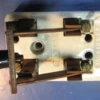@Robbin posted:I was able to examine an M1(A or B) up close and noticed that driver 2 and 3 of 4 do not have flanges. Silly me. I figured that this was just a feature of my model engine and never dreamed that the real thing also might have to negotiate sharp curves and would not want all the drivers flanged (see photo). Just for reference the K-4 does have all three flanged but it seems that the four (and assume five driver engines) it might depend on the wheel base of the drivers. So this definitely clears the way in my mind to having as sharp as O96 or 48" radius curves and two rail engines like an M1 and J1 that I would assume also dont have to have all the drivers flanged! Just like the real thing.
I only own two 2R Steam engines and all drivers are flanged (Pacific and Niagara 4-8-4). I understand your excitement. Before making the assumption that the 2R models follow the prototypes, I think it would be worth checking with 2R guys if that is the case. Hopefully they post to this topic, but if they don't you may want to start a topic on that.





